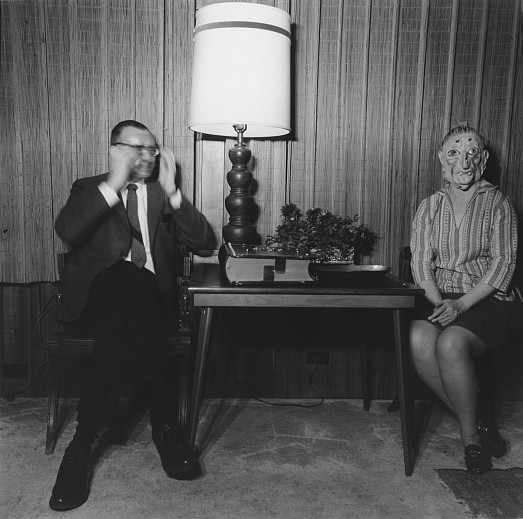
Ralph Eugene Meatyard: Completing the Story
October 20, 2023 - James Rhem
It's been said that a writer only begins a book; it is the reader who completes it. This is true of writers, but it's also especially true of a photographer like Ralph Eugene Meatyard. Indeed, as one of Meatyard’s best friends, the writer Guy Davenport once observed, many of Meatyard’s photographs are like “charming short stories that have never been written.” The sense of a mysterious, enigmatic narrative in Meatyard’s work is very strong as is the sense of an invitation to enter into completing it by the viewer. Perhaps the strongest example of this in Meatyard’s work comes in his last well-known series The Family Album of Lucybelle Crater. The invitation to the viewer to enter into the creative process of completing that work begins with the title. Everyone has a concept of the family, and almost everyone has an idea of a family album. The chiastic captions (Lucybelle Crater and Fatherly Friend, Lucybelle Crater) added to each photo only enhance the invitation to wonder about the characters and the interrelations of the figures compiled here into a family album. One wonders who they were and what their relations and interrelations were. In that wondering one is creating a kind of narrative, and through that narrative a sense of meaning. As Jonathan Gottschall, has written recently in The Storytelling Animal: How Stories Make Us Human, “We are, as a species, addicted to story . . .”, and “The story telling mind is . . . addicted to meaning.” The strength of the Lucybelle series, and thus part of its success, derives from the fact that it stands on a model viewers already have –the family. We’re presented with enigmas in the masked figures, but we're invited to place them in something we already have a notion of. Although the masks are alienating in a way, the concept of the whole is familiar and welcoming.
Meatyard’s artistic strategy is relational and exciting. It's one he pushes further in three perhaps less welcoming but more instructive series presented in the current show at the Gitterman Gallery. These leave the model of the family behind, replacing it with organizational models with absurdist names - American Cockroach and Black Beetle Solvent Co., Bird in the Bush Infant Welfare Centre, and Disabled Living Activities Group. Perhaps more than any other examples of his work these series reflect Meatyard’s wide reading in philosophy. As he surely understood, when philosophy reflects on the comic absurdity of mortality, it repeatedly suggests that life bears only the meaning we give to it.
While Meatyard leaves us largely on our own to imagine the meaning of these series, perhaps he leaves clues as to his own view: he’s populated them with figures from Lucybelle.
James Rhem is an independent scholar in the history of photography and a well-known local arts critic. His publications include the award-winning Ralph Eugene Meatyard: The Family Album of Lucybelle Crater and Other Figurative Photographs, DAP 2002), the Photo Poche Meatyard, and the Phaidon 55, Aaron Siskind, as well as numerous catalog essays on other 20th century photographers.
Back to News
